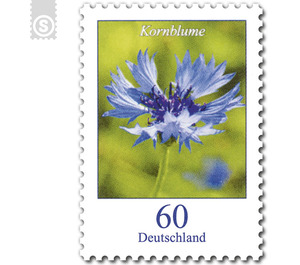Definitive Series "Flowers" - Cornflower - Germany / Federal Republic of Germany 2019 - 60 Euro Cent
Theme: Flora
| Country | Germany / Federal Republic of Germany |
| Issue Date | 2019 |
| Face Value | 60.00 |
| Color | green blue |
| Perforation | 14 |
| Printing Type | Multicolor offset printing |
| Stamp Type | Definitive |
| Item Type | Stamp |
| SID | 233153 |
| Dimensions | 22.00 |
| In 38 Wishlists | |
For many centuries, the cornflower (Centaurea cyanus or Cyanus segetum) was firmly anchored in our landscape as a typical companion of cereal fields. This circumstance brought the plant already in the Middle Ages their German name. In the meantime, unfortunately, it has become rare: intensive fertilization and the excessive use of pesticides have caused a rapid decline of once lush stocks. Thanks to counteracting measures you can now meet the bright blue flower more often. The cornflower thrives best in sunny locations on humus rich, well drained, loose and slightly calcareous soils. But tolerated is also nutrient-poor and partly sandy soil, which is why wild specimens are occasionally found on brownfields or in the wastelands. The open, round and flat inflorescences are surrounded by a wreath of blue to slightly violet tubular flowers, which characterizes the cornflower as a daisy family. After flowering from May to September and the following fruit ripeness, the annual summer flower dies.


